
Cherry U-Pick Orchards in Central-East British Columbia in 2025, by county
Below are the U-Pick orchards and farms for cherries that we know of in this area.
Not all areas of a province or region have cherries orchards that are open to the public. If you know of any others, please tell us using the add a farm form!
Remember to always check with the farm's own website or Facebook page before you go - or call or email them if they don't have a website or Facebook page. Conditions at the farms and crops can change literally overnight, so if you want to avoid a wasted trip out there - check with the farm directly before you go! If I cannot reach them, I DON'T GO!
PLEASE report closed farms, broken links and incorrect info using the "Report Corrections" form below.
New! As inflation remains high, see this page for
reliable (tested) brands of generic canning lids at lower
costs, and cost-saving measures for
getting fruit and vegetables and home canning.
If you are having a hard time
finding canning lids, I've used these, and they're a great price & ship in 2 days.
New! Road tripping and camping is a great way to have a fun, safe and inexpensive family trip. The national and state parks and monuments are open, and campgrounds usually cost between $10 and $40 per night. September to November is the best camping weather. See our new website Road Tripping and Camping.com for tips, tricks, guides, checklists and info about parks, monuments and other places to visit.
New! We just went live with our latest website, FunFactoryTours.com - As they name implies, you can find a fun factory tour, including chocolate, automobiles, historical forts and sites, famous buildings, Active Federal facilities even fun geology: like fossils and volcanic areas
Columbia-Shuswap
- Tasty Acres - cherries, strawberries, raspberries, apples, grapes and flowers
4360-30th Street Ne, Salmon Arm, BC V1E2A3. Phone: 250-833-4821. Email: tastyacres@telus.net. Open: for cherries Monday to Saturday from 8 am to 12, and if we are home in the afternoon; strawberries by appoint,ment. Directions: From Highway 1 turn North at McDonalds onto 30th Street NE. Follow 30th stree for 3 kilometers. Tasty Acres is on the right hand side of the street. You will see the sign. For a map to our farm, . Click here for a map and directions. Payment: Cash, only.
Tasty Acres Facebook page. Picking updates: Click here for picking updates Cherry season is from June 18 till mid July this year. CHERRY PICKING STARTS SATURday typically in mid JUNE. We have a variety of cherries: bing, vans, sweetheart, lamberts etc. We have strawberries as well, but since the plants are new, that crop won't come in till sometime in July or later (call before you come).For strawberries we have Albion, which is a firm, very sweet, big strawberry.If you want to come and pick strawberries, please give us a call and we will set up a time for you to come and pick. Raspberries tpyically start in early July; Grapes and apples are ready in July and August We have a U-pick section, which provides cherries, blackberries, raspberries, strawberries, apples and grapes and flowers.(ADDED: June 23, 2016)
Thompson-Nicola
- Hoodoo Ranch - ORGANIC, cherries, apricots, peaches, plums, pears, apples and saskatoons
9730 Highway # 8 P.O. Box 171, Spences Bridge, BC V0K 2L0. Phone: 250-819-5764. Email: tanya@hoodooranch.ca. Open: on weekends from June to October. Directions: Turn off the Trans Canada Highway # 1 onto Highway # 8 at Spences Bridge. Hoodoo Ranch is on the Nicola River five kilometers from the junction. We are certified organic for all . Click here for a map and directions. Payment: Cash, only.
Hoodoo Ranch Facebook page. crops! Notes: is a Certified Organic Producer certified by STOPA Farm #133. We-pick and U-pick services are offered and customers are invited to enjoy a swim and picnic afterwards at the ranch. We also have fresh picked tomatoes, peppers, cucumbers, squash etc. Click here for our Facebook page (UPDATED: July 06, 2018)
Cherry
Cherry Picking Tips, Recipes and Information
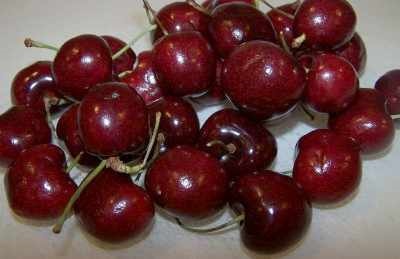 If
you are about to pick cherries either directly from a tree, or from a local
orchard or market, here's what you need to know to pick the best cherries.
If
you are about to pick cherries either directly from a tree, or from a local
orchard or market, here's what you need to know to pick the best cherries.
Cherries are a fairly early crop, flowering soon after the last frosts in April and May, setting fruit in June, usually at the same time as strawberries in most areas (but check your area's harvest calendar and call the farm or orchard you are planning to go to a few weeks ahead).
Types of Cherries
There are two types of cherries: sweet cherries and sour cherries (also called tart or pie cherries). The difference is simple:
- Sweet cherries taste
sweeter and are eaten fresh.
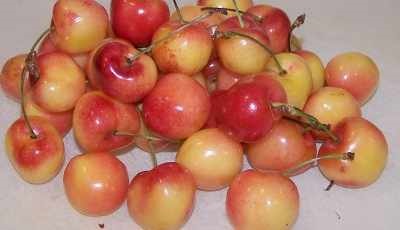
- Pie cherries are very tart and most people prefer to use them in pies, jams, preserves, jellies and butters, adding sugar to sweeten them.
See further down this page for a list of common cherry varieties and their uses. Washington State, California and Oregon are the primary sweet cherry growing states; they produce almost 90 percent the U.S.'s cherry crop. Michigan produces about 74 percent of tart cherry production. We have a master table of cherry varieties, sweet and sour (pie) in the order in which they ripen.
Cherry picking tips
- Pick ripe: Cherries, like peaches, continue to increase in size until they are ripe. They should be picked when they are of maximum size and full-flavored.
- But not under-ripe: Cherries picked before they are fully mature will not ripen
off the tree.
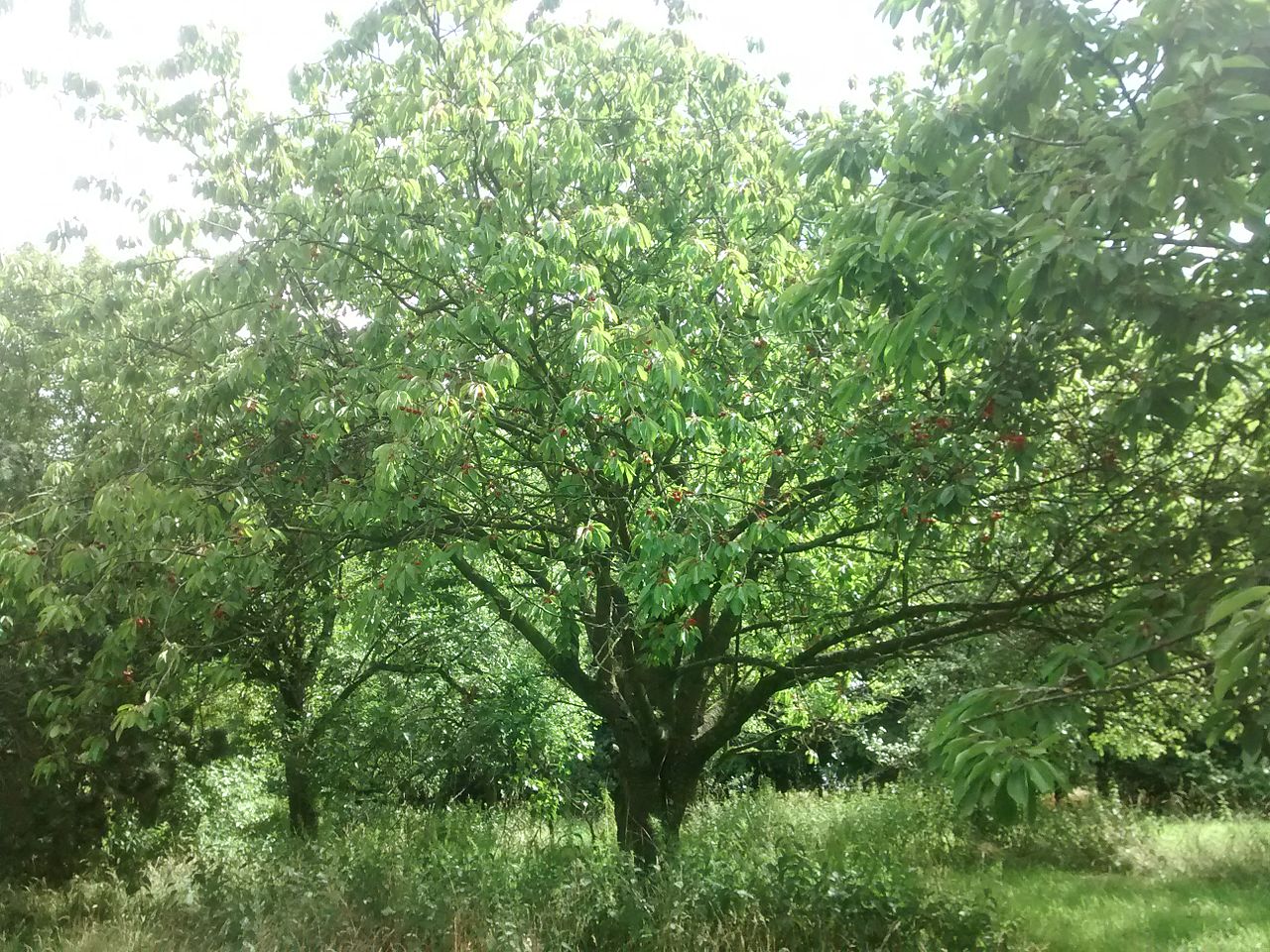
- And not over-ripe: when they become soft, mushy or discolored.
- Pie or sweet: There are 2 main types of cherries: sweet cherries that taste sweet and tart when you eat them fresh, and sour (also called pie cherries) which are too tart for most people to want to eat fresh.
- For all varieties of sweet cherries, the darker the cherry is the sweeter it will be. If you like more sour cherries the lighter red and less ripe, the more tart it will be.
- Stem separation: Sweet cherries become firm when ripe (the stems usually stay attached when you pick a sweet cherry), and sour cherries part easily from the stem.
- Leave the stems on sweet cherries: Cherries that are to be shipped will keep longer if the stems are left attached. They will store in the refrigerator for two to three days.
- Appearance: Look for heavy, firm cherries with a shiny skin and fresh stem.
- But for immediate use, they can be picked with or without the stems.
How to pick the cherries from the tree
- Gently grasp the berry with your fingers and thumb, and
- tug gently.
- If it is ripe, it will easily come off in your hand, with the stem attached.
- Repeat these operations using both hands until each holds 3 or 4 cherries.
- Carefully place - don't throw - the fruit into your containers. Repeat the picking process with both hands.
- Don't overfill your containers or try to pack the cherries down.
General Picking Tips
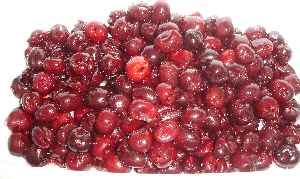
Whether you pick Cherries from your own trees, a market or at a Pick-Your-Own farm, here are a few tips to keep in mind:
- Part the leaves with your hands to look for hidden cherries ready for harvest.
- Avoid placing the picked cherries in the sunshine any longer than necessary. It is better to put them in the shade of a tree or shed than in the car trunk or on the car seat.
- Cool them as soon as possible after picking. Cherries may be kept fresh in the refrigerator for two or three days, depending upon the initial quality of the berry.
Before you leave to go to the farm:
- Always call before you go to the farm - Cherries are affected by weather (especially rain and cooler temperatures) more than most crops. And when they are in season, a large turnout can pick a field clean before noon, so CALL first! Always call before you go to the farm - Cherries are affected by weather (especially rain and cooler temperatures) more than most crops. And when they are in season, a large turnout can pick a field clean before noon, so CALL first!
-
 Get
there early. On weekends, then fields may be picked clean by NOON!
Get
there early. On weekends, then fields may be picked clean by NOON! - Bring containers -
Most growers furnish picking containers designed for Cherries, but they
may charge you for them; be sure to call before you go to see if you need to
bring
containers.
If you use your own containers, remember that heaping Cherries more than 3 inches deep will smush the lower cherries. Plastic dishpans, metal oven pans with 3 inch tall sides and large pots make good containers. I like the Glad storage containers like the one at right. - Drinks and snacks - Bring something to drink and a few snacks; you'd be surprised how you can work up a thirst and appetite! And don't forget hats and sunscreen for the sun. Bugs usually aren't a problem, but some deet might be good to bring along if it has been rainy.
When you get home
- DON'T wash the cherries until you are ready to use them. Washing makes them more prone to spoiling.
- Chill: Cherries are more perishable than blueberries or strawberries, so make a point of refrigerating them as immediately as possible after purchase. Temperatures between 34 F and 38 F are best, but, be careful not to freeze cherries! (Fresh cherries are highly prone to freeze damage).
- Spread out: Pour them out into shallow pans and remove any mushed, soft or rotting cherries
- Eat or freeze: Even under ideal conditions cherries will only keep for a few days in a refrigerator, so for best flavor and texture, consume or freeze them as soon as possible after purchase.
- See my How to freeze berries page. (Unless you're going to make jam right away)
- Now, get ready to make Cherry jam - It is VERY easy - especially with our free Cherry preserves instructions - illustrated and easy or cherry pie filling
Cherry Recipes, Canning, Jam, Jelly, and related resources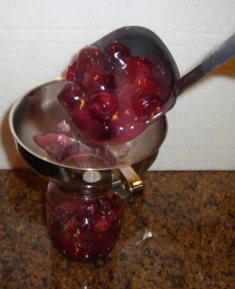
- Cherry preserves instructions - illustrated and easy
- Cherry jelly
- Cherry pie filling
- Cherry butter
- Cherry festivals
- Cherry pitters - reviews and where to get them
- How to pit cherries - several methods
Cherry varieties
For a master table of cherry varieties in the order in which they ripen, click here.
Sweet cherries:
- Bing cherries are deep red in color and sweet.
- Blackgold - very late mid-season. Good for eating fresh. Self-fertile.
- Brooks - a large, firm red cherry that tolerates hot climates. Sweet with both complex flavors and a sweet tart blackberry-like
taste.
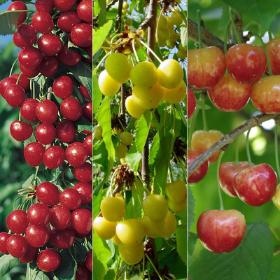
- Chelan - deep, mahogany red, heart-shaped, medium sized, sweet fruits, like Bing. Sweet, between 16 and 18 % sugar.
- Coral Champagne - very large, red, super sweet fruit that is often preferred to Bing. Firm, but juicy flesh with a coral pink color center.
- Emperor Francis are White or Blush Sweet Cherries, Early season, perfect for canning, making jellies and jams, or making homemade maraschinos.
- Hartland, an early season dark cherry. A Windsor cross, it was developed in New York
- Hedelfingen is a later season sweet cherry. It has large, black fruit.
- Kristin cherries are a a mid-season cherry developed in New York.
- Lambert Cherry is a large, black, late harvest cherry of very good quality, compared to Bing.
- Lapins Cherry is a self-fruitful, large, dark red sweet cherry from Canada with firm, good flavor. Ripens a few days after Bing and needs only 400 chilling hours or less to produce fruit.
- Orondo Ruby - A ruby red color with some gold coloring, this is a sweeter, brighter variant of the Rainier cherry. Marcus Griggs of G&C farms found this in his Rainier cherry orchard. They have a brighter red color to them and a sweeter and a bit more acidic.
- Rainier cherries are golden yellow with a pink or red blush. Rainier cherries are large and sweet.
- Royalton cherries are large, dark cherry mid-season cherries
- Sam - early ripening, large, black sweet cherry. Ripens 11 days after Vista.
- Skeena cherries are a late ripening variety. They are dark red, firm and juicy.
- Somerset cherries are medium sized, later season cherries that are dark and firm.
- Sonata - Very large, black, and moderately sweet fruit. Self-fertile.
- Staccato cherries are a deep purple-red and also a late season variety. Staccato cherries are large and one of the sweetest varieties.
- Stella are a large, sweet, dark-red fruit that ripens in mid-season
- Sweetheart cherries are a large, bright red late-season variety, medium sweetness
- Sunburst - large, firm fruit. Old productive variety. Self-fertile.
- Symphony - bright red, medium-sweet very large fruit. Late season. Self-fertile.
- Tehranivee - mid-season cherry developed in Ontario, Canada. Cracking can be a problem. Self-fertile.
- Ulster - medium-sized, firm, dark cherry, Ripens about 2 days after Vista.
- Vandalay - Large, red fruit with an unusual kidney shape. From Canada. Self-fertile.
- Viscount - medium-large, firm, good, dark red cherries. Late season ripening.
- Vista - the cherries are very dark, almost black. Large excellent-quality fruit. Mid season, ripens around the last week in June.
- Viva - dark red, 3/4 inch fruit from Canada. Ripens around July 4.
- White Gold are a blush cherry of moderate to large size.
Pie, Sour or Tart Cherries (all different names for the same thing!)
- Balaton Ujfeherto Furtos is a Hungarian sour cherry with firm fruit that is suited to picking by hand and eating fresh. Red skin and flesh. Ripens about 7 to 10 days after Montmorency
- Danube Erdi Botermo has dark red fruit with a unique sweet-tart flavor. Delicious eaten fresh or in baked goods. Ripens about 1 week before Montmorency.
- Dark-juice-tarts has juice that is red rather than clear in color.
- Jubileum - new, from Hungary. Very large with a dark red flesh. Sweet for a tart cherry, not quite as tart as Montmorency.
- Meteor - Medium-sized fruit with an odd shaped pit. Ripen s3 to 7 days after Northstar.
- Montmorency, the most commonly grown, traditional cherry for pies, baking and canning. Ripens around the last week of June to the first week of July.
- Morello Sour Cherry is a late-ripening tart dark red to nearly black cherry used for cooking, and sometimes eaten fresh when fully ripe. Fruits in warm climates ( 500 hours or fewer chilling hours below 45 F) Self-fruitful. USDA
- Northstar - Medium-sized, dark red fruit.
- Surefire - A new late blooming variety from Cornell. Bright red, medium sized fruit.
Cherry Facts and Tips
- Cherries come in many colors besides red: there are also dark red (almost black), yellow, blush (mixed) and gold cherries.
- Cherries are a very healthy food; they are high Vitamin C and naturally have no fat, cholesterol or sodium. They are also a good source of ivitamin A, calcium, protein, and iron.
- Cherries are an antioxidant-rich foods.
- One cup of cherries is less than 90 calories and 3 grams of fiber.
- One cup of cherries has 260 mg of potassium which plays a key role in muscle, heart, kidney, and nerve cell functions.
- Cherries are high in fiber. Half to one pound of cherry fruit per day can provide twenty to thirty grams of fiber which is adequate for an adult daily nutrition requirement.
- Do the math and be careful not to over-purchase as Cherries quickly mold when left at room temperature, and only last a couple of days in the refrigerator.
- You can easily freeze cherries that you cannot use right away - just wash, cut the hulls off and pop them into a ziplock bag, removing as much air as possible. Those vacuum food sealers REALLY do a good job of this! The cherries will keep for many months frozen without air. See my How to freeze berries page
- Anthocyanins in cherries are what give the fruit its red color and help protect the heart and surrounding tissues
- Some research has found eating cherries to reduce pain and inflammation associated with arthritis and gout
Other Local Farm Products (Honey, Horses, Milk, Meat, Eggs, Etc.)
(NOT pick-your-own, unless they are also listed above)
- Farm markets and roadside stands
- Local Honey Finder
- Local Meat, Milk and Eggs
- Venues: Farms, Wineries, Orchards for your event, wedding or party
- Easter egg hunts
- Children"s consignment sales
- Fruit and vegetable festivals
- Winery tours and wine tastings
- Horse rides, stables, lessons, trails
- Maple Syrup farms and sugarworks
- Bed & Breakfasts on Farms, Wineries, Ranches and Orchards
- Pumpkin patches
- Corn mazes
- Zombie Paintball venues
- Christmas Tree Farms & lots
- Environmental resources
- Consumer fraud information
- Wholesale food sources
- Resources for Farmers
Looking for canning equipment and supplies?
Water bath canner with a jar rack
Pressure canners for gas, electric and induction stoves: Presto 23Qt or T-fal 22Qt
Canning scoop (this one is PERFECT)
Ball Blue book (most recent version)
Jars: 8oz canning jars for jams
Find Other types of farms:
Farm markets and roadside stands
Road trips and camping resources
Local Honey, apiaries, beekeepers
Consumer fraud and scams information
Home canning supplies at the best prices on the internet!
Maple Syrup Farms, sugarworks, maple syrup festivals
Environmental information and resources
Farms For Your Event for birthday parties, weddings, receptions, business meetings, retreats, etc.
Festivals - local fruit and vegetable festivals
Get the
most recent version of
the Ball Blue Book
With this Presto 23 quart pressure canner and pressure cooker, you can "can" everything, fruits, vegetables, jams, jellies, salsa, applesauce, pickles, even meats, soups, stews. Model 01781

You can make jams, jellies, can fruit, applesauce, salsa and pickles with water bath canners, like this Granite Ware 12-Piece Canner Kit, Jar Rack, Blancher, Colander and 5 piece Canning Tool Set

